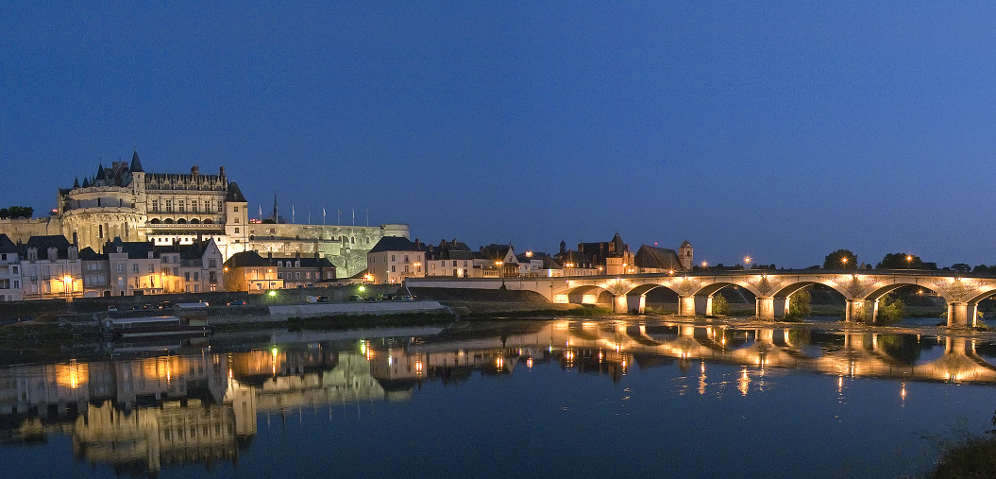About-France.com
- the connoisseur's guide to France
Amboise - stronghold on the Loire
| On this page | Location and access | Sites and attractions |
| In the area | Where to stay |
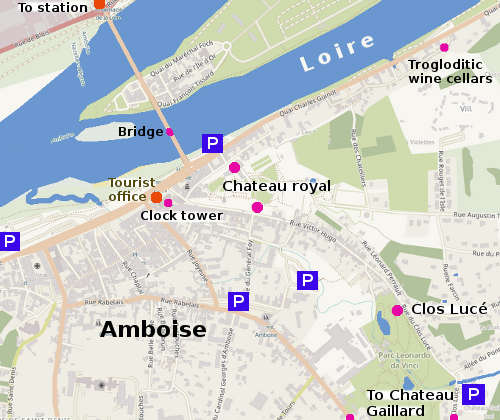 Amboise.
Parking. The parking areas indicated with a P offer free parking. there
is also paid parking on the streets in the historic centre - except in
pedestrian areas - and at the foot of the Castle.
Amboise.
Parking. The parking areas indicated with a P offer free parking. there
is also paid parking on the streets in the historic centre - except in
pedestrian areas - and at the foot of the Castle.Yet Amboise should be on the route of anyone visiting the Châteaux of the Loire. Not only does Amboise have it fine château to visit, it actually has three of them, or four if you count the great Château d'Amboise as two, the old medieval fortress and the Renaissance chateau that was later built within it.
Yet Amboise remains a small town, and its historic centre has the character of a small town. The old town stands on the south bank of the Loire, yet much of the town's more recent industrial and commercial development has been on the north bank, beyond the railway tracks.
A short History of Amboise
Occupying a buttress overlooking the river Loire, at a point where the wide river is divided in two by an island, the site of Amboise has been occupied for well over 2000 years. The Celts occupied the site before the Romans conquered Gaul, and set up a camp there. Nothing however remains of Roman Amboise – the Roman camp was doubtless built of wood, and the site was invaded and pillaged on several occasions between the second and the twelfth centuries.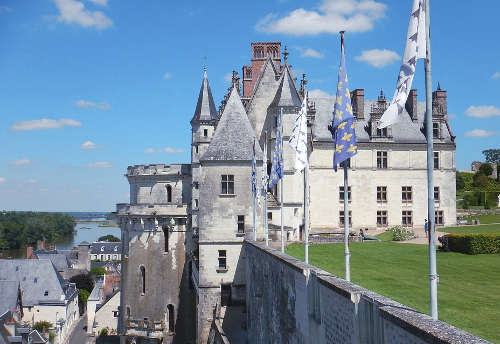
The royal château of Amboise, and the Loire behind it
In around the year 880, King Louis II of France had a new fortress built, and at its foot a new bridge over the Loire. For four hundred years, during the early Middle Ages, Amboise was an important staging post on the Loire, and reputedly the best-fortified location in the whole of the west of France. In the early fifteenth century, the end of the Hundred Years' War in northern France consolidated the power of the kings of France, who from the Treaty of Arras in 1435 on, effectively ruled the whole of the north of the country.
Amboise, the strongly fortified castle dominating the Loire, became a key royal residence, and one in which a number of French prices and future kings including François 1st would spend part of their childhood and be educated. In 1498 King Charles VIII began modernising the medieval castle and turning it into a modern château; the wortk was continued by Louis XII and François 1st, and it was François who invited Leonardo da Vinci to come and live in Amboise, in the nearby Clos Lucé,while he worked on plans for other residences.
Leonardo died in Amboise in 1519, and was buried in St Florentin's collegiate church. After the French Revolution, his bones - or at least supposedly his bones - were moved and reburied in St Hubert's chapel, in the château.
From the 16th century on, the château in Amboise, and with it the town, declined in importance. The medieval bridge was destroyed in a flood in 1789
In 1846, the railway reached Amboise, but the station was on the other side of the river. The fine stone arched bridge over the Loire which stands today, the Pont Général Leclerc, was built in the same year, to connect the town to its new railway station, replacing a temporary wooden structure.
Attractions and monuments in Amboise
- The Royal château of Amboise. The Renaissance château, overlooking the Loire, was an important royal residence in the sixteenth century. It stands within the medieval ramparts that for centuries made the site one of France's best protected castles. Time and disasters took their toll at Amboise, and the château that stands today is only part of the larger building that once occupied the site. Chateau entrance tickets available online ► here .
- St Hubert's chapel. Within the château, St Hubert's chapel is an exquisite late gothic royal chapel, restored to its former glory in the nineteenth century..
- The Clos Lucé. Within 500 metres of the Royal château, Clos Lucé is a small 15th century château once a summer residence of the Kings of France. In 1516, King François 1st, a great patron of the arts, invited Leonardo da Vinci to come and work for him, offering him the Clos Lucé as a residence. Leonardo came here, bringing many of his works including the Mona Lisa with him. The château is very well preserved, and today the building and the grounds serve as a Leonardo da Vinci museum, containing full-size models of a number of Leonardo's engineering inventions. Contrary to a popular myth, there is no secret tunnel linking the Clos Lucé to the Royal château.
- The clock tower. Fourteenth century clock tower, spanning what was once the main street through the middle of old Amboise.
- The river Loire the longest river entirely in France, the Loire is an untamed river. Its basin covers 21% of the surface area of continental France, meaning that its flow can vary hugely from season to season
- The old town. The small old town of Amboise is built at the foot of the bluff on which stands the Royal château. With its slate-roofed houses built of local white stone, it is typical of the small towns of the Loire valley area.
- The tourist train and Segway tours. Visitors can discover old Amboise on a tourist train (May - Sept.) , or by taking a guided Segway tour. Departures from outside the Tourist office.
- Troglodytic sites - the tufa rock in the Touraine area of the Loire valley is easy to cut, and since prehistoric times people have hollowed out caves in the cliffs in which to live and work. A number of local wine producers and merchants have cellars carved out of the rock. The nearest to the centre of Amboise is the Cave Drouhard ; 500m further east, la Cave au Fouées is an underground restaurant.
- Pagode de Chanteloup - quirky 18th century Chinese pagoda overlooking a lake in the grounds of a former large château that was demolished in 1823. Climb to the top for an amazing view of the countryside all round
- Chateau Gaillard - another small Renaissance château, located just south of Amboise. Very attractive gardens.
1. The châteaux de la Loire
Located between Orleans and Tours, Amboise stands in the heart of Loire château country. To the east lie the most popular and most visited châteaux of Chambord and Chenonceaux; to the west lie the smaller châteaux of the Touraine areaTours
The capital city of the Touraine area, and largest city in the Centre-Val-de-Loire region, Tours has a historic centre and a fine 13th - 15th century late gothic cathedral, with some exceptional 13th century stained-glass windows. The city's museum and art gallery has a small but good collection of European art, including works by Rembrandt, Rubens, Mantegna, Boucher and MonetBlois
Nearby Blois, on the north bank of the Loire, is the site of another major château with buildings dating from the Renaissance. There is a fine 18th century stone bridge across the Loire. Blois is classed as an Art and history town.- By air The nearest airport is Tours, which has flights from London Stansted
- By train Amboise can be reached by direct train services from Paris gare d'Austerlitz station in just over 2 hours , or by TGV from Paris Montparnasse via Tours a few minutes faster. Tickets can be bought online at Trainline.com .
- By car Amboise is under 3 hours from Paris.via the A10 Paris - Bordeaux motorway. Come off at exit 18
Copyright
© About-France.com 2007 - 2025 except where otherwise stated.
About-France.com
Home
page - Site
search
- Regions
- Maps of France
- Contact
Photo top of page : Amboise at dusk
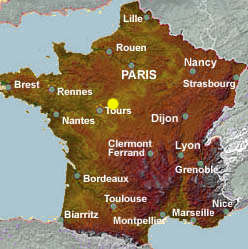
Manoir du Parc
Secluded private hotel with rooms and apartments in a historic manor close to the city centre. 500 metres from castle. Heated outdoor pool, spa.. Free parking. Restaurants close by.
★★★ Hôtel Bellevue
Three-star hotel located in the centre of old Amboise, in easy walking distance of the Royal château and the Clos Lucé. Restaurant, Free public parking close by
★★ Inter-hôtel Chaptal
Traditional two-star hotel located in the centre of old Amboise, in easy walking distance of the Royal château and the Clos Lucé. Good value. Restaurants and free public parking close by
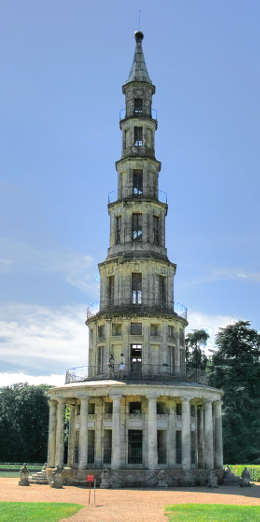
The Chanteloup Pagoda
Copyright texts and photos © About-France.com 2003 - 2025
Except:
Photo of château d'Amboise by Franceintense
Photo of Amboise at dusk by Iain G -
and photo of pagoda by Hélène Rival
both creative commons licence
.
Maps enhanced from an open-source original by Openstreetmap. org
Key
tourist information for Amboise:
Region: Centre - Val-de-Lire - central France.
Nearby cities: Tours, Orleans
Nearest airports: Tours.
Distance from Paris: 226 km (140 miles)
Population: 13,200
Main sites: The Royal château of Amboise, the Château Clos Lucé, the clock tower .
Nearby attractions and sites: The Loire châteaux..
Region: Centre - Val-de-Lire - central France.
Nearby cities: Tours, Orleans
Nearest airports: Tours.
Distance from Paris: 226 km (140 miles)
Population: 13,200
Main sites: The Royal château of Amboise, the Château Clos Lucé, the clock tower .
Nearby attractions and sites: The Loire châteaux..

Where to stay
The About-France.com selection
Hotels for all budgets and all needs
Hotels for all budgets and all needs
Historic centre
Manoir du Parc
Secluded private hotel with rooms and apartments in a historic manor close to the city centre. 500 metres from castle. Heated outdoor pool, spa.. Free parking. Restaurants close by.
★★★ Hôtel Bellevue
Three-star hotel located in the centre of old Amboise, in easy walking distance of the Royal château and the Clos Lucé. Restaurant, Free public parking close by
★★ Inter-hôtel Chaptal
Traditional two-star hotel located in the centre of old Amboise, in easy walking distance of the Royal château and the Clos Lucé. Good value. Restaurants and free public parking close by

The Chanteloup Pagoda
| ►► Site guide |
| About-France.com home |
| Full site index |
| About-France.com site search |
| ►► Principal chapters on About-France.com |
| The
regions of France Beyond
Paris, a guide to the French regions and their tourist attractions.
|
| Accommodation
in France |
| Guide
to Paris Make
the most of your trip to Paris; attractions,
Paris hotels,
transport, and lots more.
|
| Tourism in France
The
main tourist attractions and places to visit in France - historic
monuments, art galleries, and more
|
| Planning
a trip to
France
Information
on things to do before starting your trip to France.
|
| Driving
in France
Tips
and useful information on driving in and through France - motorways,
tolls, where to stay....
|
| Maps
of France
Cities,
towns, departments, regions, climate, wine areas and other themes.
|
| The French way of
life
A
mine of information about life and living in France,
|
| A-Z
dictionary
of France Encyclopedic
dictionary of modern France
|
Click here for
low-cost car hire in France
low-cost car hire in France
Copyright texts and photos © About-France.com 2003 - 2025
Except:
Photo of château d'Amboise by Franceintense
Photo of Amboise at dusk by Iain G -
and photo of pagoda by Hélène Rival
both creative commons licence
.
Maps enhanced from an open-source original by Openstreetmap. org

